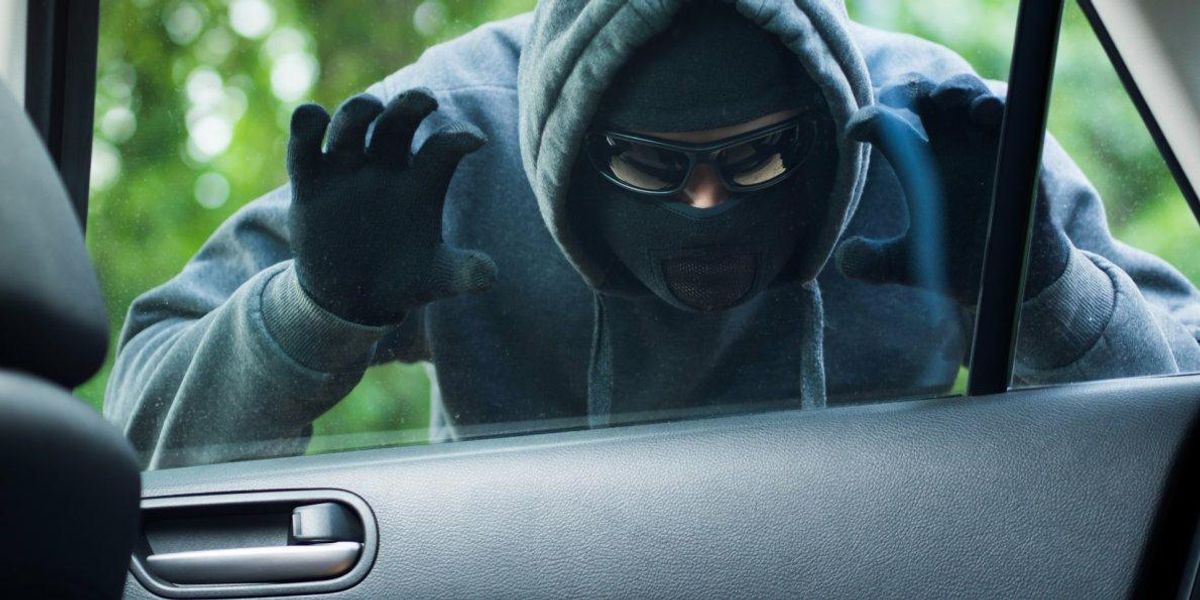Forms of a "carjacking" alert have been kicking around the Internet since at least February 2004, even though what they describe might more accurately be described as a form of automobile theft rather than a form of carjacking (which involves threatening or attacking the driver of a vehicle to force him out of his car):
Imagine: You walk across the parking lot, unlock your car and get inside. Then you lock all your doors, start the engine and shift into REVERSE. Habit! You look into the rear-view window to back out of your parking space and you notice a piece of paper, some sort of advertisement stuck to your rear window. So, you shift into PARK, unlock your doors and jump out of your vehicle to remove that paper (or whatever it is) that is obstructing your view ... when you reach the back of your car, that is when the car-jackers jump out of nowhere ... jump into your car and take off — your engine was running, your purse is in the car, and they practically mow you down as they speed off in your car.
BE AWARE OF THIS NEW SCHEME
Just drive away and remove the paper that is stuck to your window later ... and be thankful that you read this email and that you forwarded it to your friends.
Please beware that my daughter was coming out of the West York Wal-Mart tonight and as she was walking to her car she noticed that a couple of guys were watching her, she got into her car and locked her doors. As she was leaving she saw what appeared to be a 100.00 dollar bill on her windshield, she was smart enough not to get out of her car at the time because she remember a email that I sent her not that long ago about people putting something on the windshield and when the person gets out to retrieve it they are car jacked.
Here's a pic of the fake money....be careful.
Ever since the earliest warnings of this putative form of crime hit the Internet, we have been following news reports for any documented instances of an actual car theft (either perpetrated or merely attempted) that followed the script outlined in the widely-spread e-mailed caution, but we have yet to turn up evidence of so much as one. Were this "lure motorists from their vehicles by leaving flyers on their rear windows, then drive off with their cars" method as commonly in play as suggested in the example above, that surely would not have been the case. Nothing rules out there having been a few thefts carried out in the manner described that we have yet to hear about. But even if that proved to be the case, there is clearly no crime wave, no ever-present danger to motorists everywhere, no flyer-armed menace lurking in the nation's parking lots.
Our law enforcement contacts have also noted that although the process described above could be used by carjackers, they were unfamiliar with any cases of cars being taken in this manner, and the scheme outlined ran contrary to their experience of how carjackers operate. Specifically, they said that carjackings are generally crimes of opportunity, committed by persons in need of quick cash or youngsters either out for a thrill or participating in some rite of passage (such as a gang initiation). Carjackers tend to hang around places where motorists have to stop or exit their vehicles (e.g., intersections, gas stations, car washes, ATMs, freeway on- and off-ramps) and then force the drivers out of their automobiles (or simply take off with the temporarily unoccupied cars). Running around parking lots sticking flyers on windshields and then hanging around to wait for drivers to return to their vehicles involves planning and exposure atypical of most carjackers; they're more likely to approach occupied vehicles (particularly luxury cars with high resale value) and force the drivers out (by threatening them with weapons and/or physically pulling them out of their seats).
They acknowledged, however, that as improvements in car alarms, locking devices, and other anti-theft systems have made it harder to steal unoccupied vehicles, car thieves (i.e., those who boost vehicles on a regular basis, without the use of violence or weaponry) may be resorting to alternative methods such as the one described above. However, attracting attention by plastering parked cars with flyers or fake money, hanging around waiting for the drivers of those vehicles to return to their autos, and hoping that those motorists don't remove what was left on their windshields or windows before entering their cars (rather than afterwards) isn't a terribly efficient scheme for grand theft auto.
This alert has gained a measure of credibility thanks to it having been forwarded by members of the law enforcement community. Illinois State Police Master Sgt. Terry Granell received the warning via the usual method (a friend e-mailed it to him), thought it something he should pass along to his daughters, and so unthinkingly volleyed it to them from his work account, which automatically appended his official signature block to the mailing. Taking their dad's e-mail for an official announcement from the Illinois State Police about a mode of crime that agency was dealing with, the alarmed girls passed along the heads up about leaflet-armed carjackers to their friends, who in turn loosed it upon a wider audience. As it sped from one inbox to the next, the alert was presumed authentic because it carried the contact information for a real police officer.
Yet appearances to the contrary, Sgt. Granell's e-mail wasn't an official statement made on behalf of the Illinois State Police about a form of crime it had noted and wanted the public to guard itself against, it was merely the passing along of a dubious e-mail by a private citizen who just happened to be a police officer. Later versions of this e-mail identified Sgt. Granell as being a member of the Louisiana State Patrol or Louisiana State Police.
One of the many versions in circulation commenced:
Detective Bledsoe, of the Florissant, MO Sheriff's office confirms that this is happening in St. Louis County, Missouri and could be happening near you, so be careful and take note. Leutenant Tony Bartholome of the Missouiri Highway Patrol urges everyone to keep this email circulating — the more people who are aware of this MO, the better. Description of new carjacking scheme:
The Florissant (Missouri) Police Department posted a denial of this claim on their web site:
ERRONEOUS E-MAIL CAUSES ALARM IN CITY OF FLORISSANT
Chief William Karabas of the Florissant Police Department wants to make the public aware of an erroneous e-mail circulating in reference to auto thefts, specifically 'car jacking' incidents in the City of Florissant.
"I want to put an end to this rumor. The City of Florissant has not had any incidents of this nature!", said Chief Karabas. In fact, the e-mail makes reference to many false claims. Chief Karabas stated, "Some of the points include, referring to the Florissant Police Department as a Sheriffs Department, which we are not, we DO NOT have a Detective Bledsoe, there is NO State Trooper named Bartholome, there is NO Missouri Neighborhood Watch Association, there is NO such address (1456 Washington Ave) in Florissant and the telephone number given on the e-mail is NOT IN SERVICE!"
Again, there is NO validity to this e-mail. It is FALSE. We ask that people be informed and get the correct information. One way to check e-mails for validity is to call your police department or go on-line to check â??Urban Legendsâ?? at www.snopes.com
Detective Bledsoe of the infamous warning notoriety is an actual police officer, but he serves with the Montgomery County (Texas) Sheriff's Office, not the Florissant Police Department. (Montgomery County is just north of Houston.) He came to have this Internet can tied to his tail after receiving the "carjackers using flyers to lure victims from their vehicles" warning in his e-mail in February 2005 and sending it to some friends as an example of what possibly could happen, not realizing that his official signature block would be automatically appended to his forward. He has no personal knowledge of carjackings being carried out by this method, he has not been party to any such investigations, nor was his e-mail meant as an official alert on behalf of the Montgomery County Sheriff's Office. Since February 2005, Det. Bledsoe has fielded more than 300 phone calls about the warning many presume he authored, with inquiries coming in from all over the country.
There is a Lt. Tony Bartolome, but he's with the Florida Highway Patrol, not Missouri's. His involvement with the e-mail began in 2004. As Lt. Bartolome stated on the FHP web site: "I got that information four and half years ago from the San Diego police. I passed it on to a couple of friends. I wish I'd never sent it."
San Diego police Sergeant Jim Shorr said he's seen the message on the Internet, but to his knowledge San Diego hasn't had any cases like it. "It was attributed to us," he said. "But I don't know where it came from."
New Zealand experienced a resurgence of the rumor in 2009 when a version in circulation that included the name of a police employee and the NZ Police logo made the rounds. The New Zealand Police said that the rumor "is an urban myth":
Police are urging people who receive an email about tactics used in supposed 'carjackings' to delete it rather than forwarding it to friends and family, as it is an urban myth. The email has been around for some time and appears to be experiencing another circulation surge at the moment. It gained momentum earlier this year as it contains the name of a Police employee and the NZ Police logo — lending it credibility. The email was passed on, albeit with the best of intentions, by the employee, gaining the staff member's details and Police logo in the process. The email warns recipients to be on the lookout for a piece of paper stuck to the rear window of their vehicle, seen only as they back out of parking spaces. The scenario suggests people then get out of their vehicle to remove the piece of paper, leaving keys in the ignition, the engine running and their bags/purses and other valuables in the car. When the vehicle owner gets out of their car, waiting 'offenders' then take the car and its contents. Police say it is easy for people to be taken in by such stories, evidenced by the fact a Police employee saw fit to forward the email on. Police say it's simply not good practice to exit a vehicle with keys in the ignition, the engine running and valuables inside.
In December 2009 the e-mail was attributed to Mark Scheck, an officer with the RCMP in Wetaskiwin, Alberta. While the officer is real, his connection with the e-mail was not, as an article in the Wetaskiwin Times confirmed.
In November 2014, Washington, D.C., television station WJLA ran a muddled news report about a new satellite office of the Maryland attorney general issuing a warning about "carjackers" or "scammers" (they couldn't decide which) leaving $100 bills (or fakes that look like $100 bills, they weren't clear which) under the windshield wipers of cars parked at malls and then taking off with those vehicles when their drivers exit them to snatch the money. But again, the whole news story was based on nothing more than someone at the attorney general's office saying they had "gotten reports of scammers in Maryland leaving $100 bills on windshields" and provided no documented instance of such a crime actually having taken place. The attorney general's office told us they had received only a single (unconfirmed) report of this supposed crime wave, but "due to the severity of the issue, we have reported it to make people aware of it."


